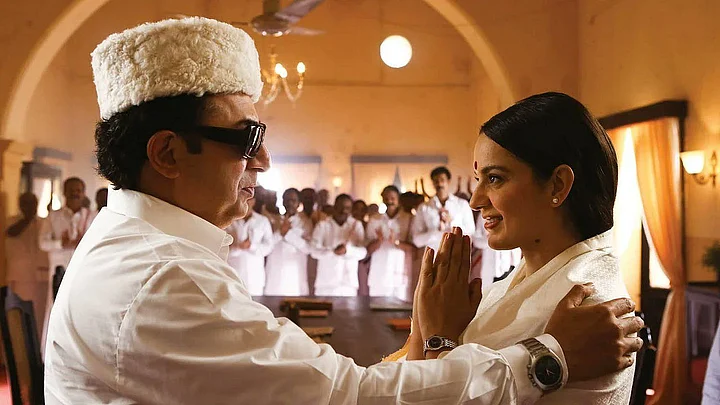The take on the power politics of J.Jayalalithaa (1948-2016) – the multi-lingual Thalaivii – has evoked a mixed response. The division is not so much about the quality of the film as it became a troll slug-out on social media, whether Kangana Ranaut was the right fit for the role or not.
Indeed, the comments reflect a divide between the actor’s staunch loyalists and her firm detractors. Her affinity to the BJP party and her frequent controversial statements have slanted the appreciation of or aversion to the film, never mind its merits of demerits.
Thalaivii is, in fact, the second prominent film after Mani Ratnam’s Iruvar (1997) on the ‘Iron Lady’, who was the Chief Minister of Tamil Nadu six times. Add to that Queen, the 11-episode Tamil series showcasing Ramya Krishnan as Jayalalithaa.
Sporadically, at least three more projects by filmmakers in South India –including the six National Award-winning Bharathiraja - were announced based on the unbridled power wielded by Jayalalithaa, but they didn’t materialise, perhaps stymied by the objections which could be raised by her surviving family.
Carrying a disclaimer that no attempt is being made to recreate reality and the assertion that the aim is to narrate fiction worked - not without some censorship dos and don’ts for Iruvar and Queen. Apparently, altering a few real life names, dramatic licence, and certain script situations presented as figments of the imagination, served as quick-fix remedies.
The larger point, however, is to what degree can CM Jayalalithaa be depicted with authenticity by cinema.
None of the representations have come close to the daunting actor-cum-politician one has been familiar with, even if superficially. For instance, there has been no spotlighting of her one-time foray into Bollywood.
In Izzat (1968) , she had portrayed a tribal belle breaking into a rambunctious, titillating song which went 'Jaagi Badan Mein Jwala…Saiyaan Tune Kya Kar Dala' ('My Body Has Been Awakened By A Flame…My Love What Have You Done to Me?'). Released at Bombay’s Roxy cinema, the film was a flop, despite the presence of top star Dharmendra in the double role of a dark-complexioned Dalit and a rose-complexioned half-brother.
After that Jayalalithaa never reappeared at the Roxy or at any cinema hall in Mumbai. More’s the pity. Because an intense search was on, then, for a south-of-the-Vindhya’s actor to step into the terpsichorean shoes of Vyjayanthimala. Jayalalithaa was aptly cast, but a single flop doused her ambition to seek a wider audience through Hindi cinema.
With time and twists of politics, her escalating power was much-feared, which is why I was on my best behaviour the one and only time I interviewed her, circa 2000. The conversation, at an ante-room of her Chennai house, was for the southern edition of Filmfare. The honcho of the magazine’s marketing department in Chennai emphasised that I should not ask rude questions. And I shouldn’t sip more than a single cup of tea, and wave away the biscuits suavely. Done.
At the appointed hour at noon, I was sitting nose-to-nose with the Izzat belle of my childhood. Garbed in her ubiquitous bullet-proof cloak, her complexion was flawless, her body lingo stately. We started chatting over tea (no biscuits). She was courtesy personified till I couldn’t help shifting gears to some controversial questions — better to be banished from Chennai rather than print an obsequious Q & A.
Vis-a-vis the criticism of her holding up traffic whenever her cavalcade of cars hit the roads, she remarked tersely that the interview was for a film magazine, not a civic responsibility bulletin. Quite.
Next, it was believed that Mani Ratnam’s Iruvar had invoked her wrath. Mohanlal portraying a not-so-veiled version of M.G. Ramachandran – Jayalalithaa’s mentor and ‘close friend’—with debutante Aishwarya Rai in a strange double role were a take on err... her. Right? To that Jayalalithaa had responded quite unequivocally that she did not think much of Ratnam’s skills as a filmmaker at all and avoided his films with a barge pole.
Next please? On A.R. Rahman, she went thumbs-up. Not so on Rajinikanth or Kamal Haasan, both of whom she spoke about uncharitably, to put it politely.
She eased up mercifully, switching the topic to her abiding love for English literature, inviting me to visit her personal library whenever I’m free. She spoke of Chaucer, Shakespeare, Charles Dickens, Ernest Hemingway and John Steinbeck, not as much to name-drop but to assert that she was nobody’s fool.
“It would be a pleasure to browse through your library, ma’am,” I interjected. She smiled her only one smile for the day, adding, “I will let you know when. By the way, we have great sources of Indian literature, too. Why can’t filmmakers like Mani Ratnam tap that area instead of making so-called biopics?”
Emboldened, I asked her about Izzat. Had MGR sir given her the go-ahead to act in a Hindi film? What if it had clicked big time? Wouldn’t it have been fun to become the Dream Girl of Bollywood – a crown that went eventually to Hema Malini? An ominous pause followed. That conjectural query prompted her to look meaningfully at the exit door; my time was up. We shook hands; great meeting you ma’am!
P.S: She never did let me know about my visit to her library. But there’s always been the memory of Izzat. If it had been a hit, who knows what course the history of Tamil Nadu politics could have taken?
(This piece is from The Quint's archives and is being republished to mark Jayalalithaa's birth anniversary.)
(At The Quint, we question everything. Play an active role in shaping our journalism by becoming a member today.)
